Genre: Platformer Developer: Sega Ent. Publisher: Sega Ent. Players: 1 Released: 1983
1983’s Congo Bongo (known as Tip Top in Japan) is often considered to be a rip-off of the Nintendo classic Donkey Kong, likely due to the fact that it’s a platform title that pits a human protagonist against a rogue ape. In truth, the game’s premise is slightly different. The ape is indeed causing mayhem, but there are no damsels in distress here. Rather, players take the role of a hunter seeking revenge against Bongo the Gorilla for a practical joke in which the primate literally sets the hunter’s tent on fire. That sounds more like attempted arson to me than a practical joke, but I suspect the rules are different in the jungle. Incensed (pardon the pun) at Bongo, the hunter chases him across multiple stages.
I use the term “multiple” loosely here. The original arcade Congo Bongo had four varied stages, and half of those are gone in the SG-1000 port. That’s only the first of several major differences there are between the two, and while I can excuse the graphical and audio downgrades, eliminating half the game leaves me wondering if the entire project was even worth it in the first place. Other consoles of the time, such as the ColecoVision, managed to squeeze at least three stages into the cartridge (as well as maintain the isometric perspective), and I had hoped that Sega would have led the pack with the best port of the bunch. Sadly, that is not the case. To be fair, the Atari 2600 version had two stages as well, but the SG-1000 is a more powerful machine, so one wouldn’t be wrong to expect its version to be more complete than Atari’s.
The first difference players will notice is that the game is no longer played in an isometric perspective. In the arcade, Congo Bongo ran on the same hardware as Sega’s isometric classic Zaxxon, and the view gave the platformer a neat feather in its cap to help distinguish it from the competition. The different perspective on the SG-1000 makes the gameplay a bit trickier, especially since there are no offensive weapons to be found. Players can only move and jump to avoid obstacles and being able to move in all directions on a platform make it more challenging to navigate around Bongo’s monkey lackeys and the coconuts he throws. With the change to a stock 2D view, that gameplay element is lost. The second stage allows for some vertical movement on the islands that have to be navigated to reach Bongo, but it still doesn’t manage to recreate the same feel as the coin-op original. This vertical movement can also be a bit problematic in the second stage, as it requires some precision to move from a platform onto a log to cross over water. Even being off by a little can cause instant death.
Easily as noticeable is how significantly downgraded the visuals are. The arcade version is bright and colorful, taking advantage of the Zaxxon hardware’s powerful Z80 processor. In contrast, the SG-1000 port appears dull and washed out. The main character looks more like an old lady in a beach hat and bathing suit, and the monkeys and coconuts are all a single color, black. There is dreadfully little detail in the environments, and for some reason Bongo himself looks… off. His original arcade model made an intimidating face every so often, but the SG-1000 ape looks more like a character coerced out of retirement by the promise of crystal meth. He waddles around with pecs that look like sagging breasts, randomly tossing coconuts and grinning like an idiot. It kind of ruins the atmosphere, to be blunt.
The audio is also rather weak. The music is barely there, almost drowned out by the bleeps of the hunter’s steps. I rather like sound of older chiptunes and was disappointed that the theme wasn’t more audible. I do admit that the coin-op didn’t have much in the way of music, and that annoying bleeping sound was there as well; however, it seems like this port is a missed opportunity to improve and add something that would give the SG-1000 an edge over its more powerful arcade cousin.
The control is simple enough, with the hunter only jumping in his quest to reach Bongo. No gun, no darts… no offensive weaponry at all. Not much of a hunter, is he? Congo Bongo uses the joystick and a single button, but it’s also compatible with the SC-3000 computer. The Home/CLR and INS/DEL buttons start the game and are used for jumping. To reach Bongo, players must dodge the coconuts and monkeys, jump over pits, and avoid falling off the platforms. Like Donkey Kong, there’s a bonus counter that diminishes during play. Standard arcade-type fair to be sure, but I suspect that more players will end their games out of boredom than from losing all three lives.
I don’t think I can recommend this version of Congo Bongo to anyone over say, the ColecoVison port. There just isn’t enough here to maintain interest for long, and what is there isn’t done particularly well. Congo Bongo was a great little romp in the arcades, and none of that charm made it onto the SG-1000. In all honesty, all of the conversions of the time lacked major elements, but I had high hopes for this one. Bongo just isn’t worth hunting.
SCORE: 4 out of 10.

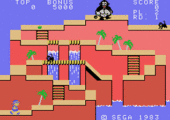
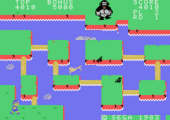
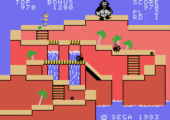
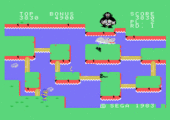
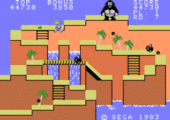
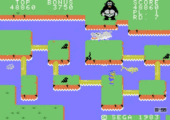
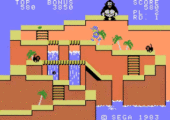
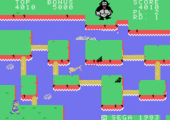
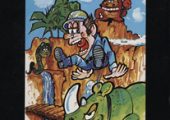
Recent Comments